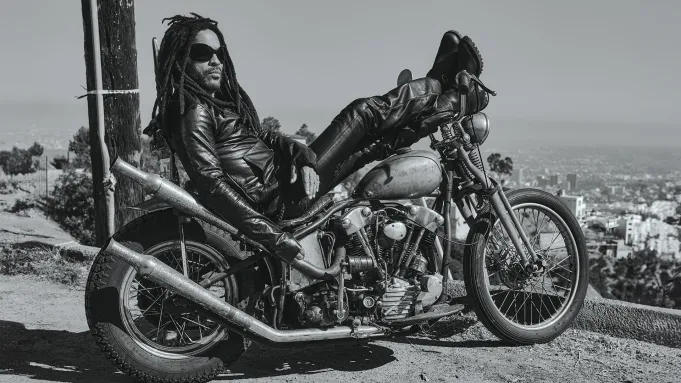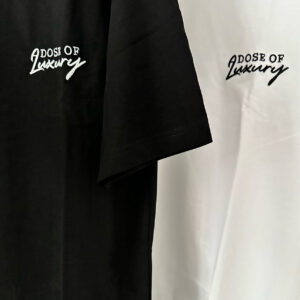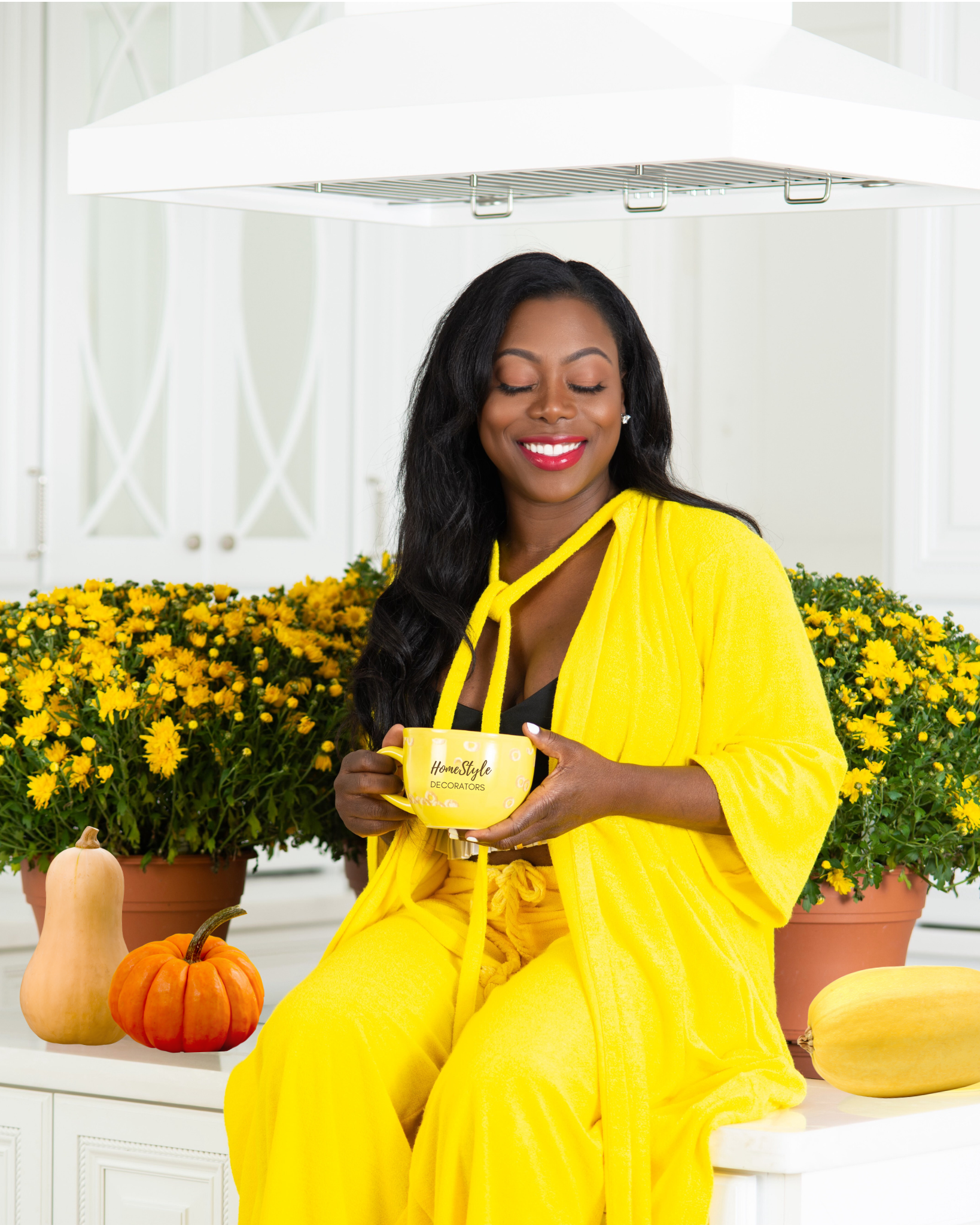
Deep within the hills of Southern California’s Topanga Canyon, on an estate overlooking the Santa Monica mountains where wind chimes ring softly in the breeze, Lenny Kravitz is explaining the concept of an opium bed to me. When he was living in New York in the late 1980s, working on his debut album, he didn’t have much bread, he says in his rock-star parlance, but knew he wanted his home to be an artistic sanctuary, a place that could invigorate and hold his music. It was the first time he took his creative instincts seriously. He decorated the columns of his SoHo loft with broken mirrors he found on the street and painted the walls to look like wallpaper. One thing he did spend money on was the sleeping area, as crucial an element of the apartment’s vibe as the birds and snakes and lizards that also lived there as pets. Kravitz, 61, shows me a photo of a canopy bed with three raised sides, like a little porch, or a funky bus station. “You’re to lay down and smoke opium, because when you smoke you fall out, right?” he says, his voice full of gravel and glitter. Thin silver bracelets jangle down his wrist while he talks. “I never smoked opium, but I had this very international bohemian-hippie vibe going on.”
That vibe led him to record Let Love Rule (1989), the album that launched more than three decades of Kravitz’s radical approach to music and much else in his life. In the years since, he has become one of the most groundbreaking musicians of his era, earning nine Grammy nominations and winning four—all for songs that have cemented his place in the culture: “American Woman,” “Fly Away,” “Again,” and “Dig In.” Even after all this time, his personal blend of rock, funk, soul, and reggae still feeds off of his unique visual aesthetic—and vice versa. In 2003, he elevated his design obsession into a full-fledged side hustle, founding Kravitz Design. The work is symbiotic: Mood boards of design plans are set to a particular soundtrack; recently, it has been the Talking Heads. “Just like music, we let the space tell us what to do,” he says. “I have to represent [the client] and then give it my vibe.”

Kravitz on his 1947 Harley Davidson Knucklehead, built by Cycle Zombies. He wears an Outsider leather jacket, $4,280, and Engineer leather boots, $4,050, both by Chrome Hearts, with his own leather pants.
Pat Martin
Kravitz has felt an affinity for both music and design since childhood. His father bought him his first guitar when he was about 10, and he considers his earliest real design project his bedroom in Los Angeles, where his family moved from a one-bedroom apartment in New York a short time later. Kravitz laughs as he remembers how excited he was to live in a bigger space after years in cramped quarters. “This house had a little yard and a pool and a view, and I was like, ‘Whoa,’ ” he recalls. “It was a sick example of a midcentury ranch-style house—glass, wood.” He tricked out his room into a proto-version of his adult loft, covered in graphic black-light posters of Jimi Hendrix and Led Zeppelin and strings of colored lights. It was the ’70s, after all. “I just made this funky little setup. I hung my lights and played my music, and I thought I was doing something.”
Now, his design company has worked with established brands like Dom Pérignon, Leica, and Rolex, and he has created everything from furniture for CB2 to Kravitz Eyewear for Ray-Ban. “What I like about our company is that we don’t have a signature,” he says. “There are ties through things—comfort, elegance, soulfulness—but you just take on things that you think are interesting.”
He has arrived in L.A. after a weeklong residency in Las Vegas, where his reputation as the epitome of cool showed no sign of waning. “Kravitz is the rare demo of 60-plus individuals who can rock leather pants in public,” read one review. He is still on the road regularly; he spent the past year and a half touring for his latest album, Blue Electric Light. The Vegas stint gave him a little bit of cabin fever: The 116-degree heat kept him inside, listening to music, reading, watching films. (One day, he hosted his friends for an impromptu marathon screening of some of Spike Lee’s best work: Malcolm X and Mo’ Betta Blues—both of which star Kravitz’s good friend Denzel Washington—plus Jungle Fever.) After this short respite in SoCal, he’s due to play some festivals in the U.S., then tour New Zealand and Australia, head back to the States for some additional dates, and hit Europe—all before the year’s end. It would be a crazy schedule for most, but for Kravitz, that kind of breakneck pace is his default mode.

Kravitz pairs a Jaeger-LeCoultre Reverso Tribute Monoface Small Seconds watch with a pink-gold case, $41,300, and a military jacket his father wore while reporting in Vietnam during the war.
Pat Martin
Travel seems to feed his soul as much as music and design do: Being in motion, delving into cultures and communities and food and experiences, soaking up everything on offer make him feel grounded. Especially because he tends to find kinship wherever he goes. “I have friends and acquaintances in different places,” he says, “so that makes it feel more like home, that you can go by somebody’s house and have a home-cooked meal and good conversation.
He was bitten by the travel bug early. As an adolescent, he had a summer job in Nigeria assisting a stage manager booking American artists such as Shalamar and Lakeside. Today, there are certain places that still have the power to snag his heart, like South America, where he says the people “are there to take in the music, to really experience it, to participate. It’s very intense there, [and] it’s really refreshing for artists to receive that kind of energy and that kind of love.”
When he’s not touring, Kravitz splits his time between three homes. His Paris residence, in the 16th arrondissement on the Right Bank, is probably the most personal. The decor features an eclectic mix of items from modernist designers he admires (Milo Baughman, Guido Faleschini), furniture from Kravitz Design’s Africa-inflected collaboration with CB2, and objects and collectibles from his life (those aforementioned Grammys, Muhammad Ali’s boots). It also functions as a base of sorts for him and his daughter, actor and filmmaker Zoë Kravitz, both of them often traveling to the city for various creative projects. “I’ve been working on it for many years,” he says. “It’s always evolving, it’s always moving.”

Photographed in L.A.’s Laurel Canyon, Kravitz wears his own vintage denim jacket from Church Boutique, Celine jeans, and Yves Saint Laurent boots.
Pat Martin
But the Bahamas is where he spends most of his days, cooking and tending to his garden: mangos, sour-sop, sugar apples, papaya, guava, passion fruit, kale, okra. (Kravitz also owns a ranch in Brazil, though he says he doesn’t get there as often as he would like.) He grew up visiting Nassau, the Bahamian capital, twice a year, but he did not step foot on Eleuthera, one of the other islands, until he was an adult. He and his then-wife, Lisa Bonet, had to ride the mail boat to get there, squeezed in alongside diapers and groceries and tires. He recounts the journey with the acuity of a moment right before everything changes—the 55-mile trip took about five hours, and the $25 fare included a sandwich and a drink. When he drank in the splendor around him, he decided to stay. “The day I arrived there, I knew it was my home,” he says.
Kravitz is a man-about-island, just a regular neighbor and resident, who will pop in and visit friends at work, who responds to Travis, a mispronunciation of his last name. One day, he was talking to a pal suffering from a toothache; Kravitz watched as the man poured black pepper into a hole in his tooth and sealed it with cardboard from a matchbox. Soon after, Kravitz began hosting an annual dental-care clinic, completely free of charge for the island’s inhabitants. “People get taken out of their pain and misery, people who have been hiding because they have nothing in their mouth, or don’t feel attractive, or don’t feel themselves—all of it,” he says. “There are still a lot of folks who need to be served, but it’s working, and it brings so much joy.”
I have friends and acquaintances in different places, so that makes it feel more like home, that you can go by somebody’s house and have a home-cooked meal and good conversation.

Lenny, Familiar Corner, 2025, oil on canvas by Peter Uka
Courtesy of the Artist and Mariane Ibrahim; Painting Photographed by Kai Schmidt
During his Vegas shows, Kravitz ended each night playing the title track from his first album, repeating the three words “let love rule” like a mantra while walking through his audience, before he vanished into a cloud of confetti. And considering the varied richness of his pursuits, there may be no better motto. Kravitz is a paragon of pursuing joy wherever it leads. His artistry is in living a fulfilled life. “If we put love and God in what we’re doing, people should feel and see the fruits,” he says. “It’s far better to show love through your actions than to speak about it.”
That unshakable trust in the forces outside himself is his channel into his art, something he has believed in his entire career. Kravitz chills in a sprawled-out rock-star posture, his back slid halfway down a reclining chair and his legs splayed out wide. I ask about one of his tattoos, a cross made of arrows pointing in the cardinal directions. He’d been drawing on a paper plate while in the studio for Are You Gonna Go My Way (1993), he replies, and it just came to him. “I didn’t know what I was drawing it for, but honestly, I thought, ‘Oh, this would make a nice tattoo,’ ” he says, noting that it represents Christ’s consciousness in all directions.
I just made this funky little setup. I hung my lights and played my music, and I thought I was doing something.
The son of Jewish television-news producer Sy Kravitz and Black actress Roxie Roker, who was of Bahamian descent, Kravitz grew up with both Christian and Jewish traditions. Though he doesn’t identify with a particular organized religion today, his language is steeped in spirituality. “Quincy Jones put it in a very eloquent way: You just want to be ready when God walks in the room, to capture what you’re being given,” says Kravitz. Ideas, he tells me, flit through space, and his job is to be an antenna, to capture them. “I’m trying to pick up on what’s floating out there. It’s given to me, and my job is to make it happen. I’ll play all the instruments, do what I have to do. But it came from somewhere else. Didn’t come from me.”

Kravitz tunes an acoustic guitar in the attic of The Record Room in Laurel Canyon.
Pat Martin
Though he hasn’t made Southern California his home since his youth, he still looks every part the Angeleno, wearing a ripped burgundy thin-mesh shirt and frayed jeans and with a few of his waist-length locs tied in a knot behind his head. His signature sunglasses—today, it’s a pair of thick wraparound lenses—shield him from the high sun. Kravitz’s family moved to L.A. after his mother landed a role on the groundbreaking TV series The Jeffersons (playing half of prime time’s first interracial couple). “I grew up around a lot of very hardworking, humble people, who had a lot of integrity, so it was all about respect, hard work,” he says. He lists Roker as an example, because her career didn’t take off until she was older, she knew who she was, was more sure of herself, her values were in place. “As a teenager, I thought she should be doing more, having more. ‘Why are we cleaning the house?’ And she’d say, ‘Because it’s our house. We have to be responsible for it.’ ”
In New York, Kravitz had shuttled between his parents’ apartment on Manhattan’s predominantly white Upper East Side and his maternal grandparents’ home in working-class Bedford-Stuyvesant, Brooklyn, as well as his paternal grandparents’ place in the borough’s Sheepshead Bay, which had a significant Jewish population. The clash among the neighborhoods mirrored his internal strife over his biracial identity. And while anyone growing up in 1970s-era New York City was exposed to new types of art and style and fashion, Kravitz’s unconventional upbringing—surrounded by leading figures of the creative set—gave him a front-row seat to that cultural flowering. His godmothers included actresses Diahann Carroll and Cicely Tyson, both good friends of his mother. Kravitz remembers going to the home Tyson shared with her husband Miles Davis and being entranced by the jazz legend’s closet. “It was full of reptile skins and suede and bright colors,” he says. “Everything was so rich and fun.”
Kravitz knows how to have a good time but also how to accommodate it—one of his pieces for CB2 is a sofa with an extra-low armrest, perfect for propping your arm up while chatting at a get together. “It’s very much a sofa made for a party house, but also very livable,” Sara Khodja, a senior director at CB2, tells me. “When I think about the collection itself, and the point of view that he brought to it, I’m like, ‘Oh, yeah. Only a rock star would do this.’ ”

The 61-year-old Kravitz looks ageless in his own Balenciaga sweatpants, his dad’s old military jacket, and sunglasses he designed for Kravitz Eyewear.
Kravitz knew he wanted to be a musician at an early age—a Jackson 5 concert at Madison Square Garden when he was about 5 years old solidified that goal for him. But in L.A., he discovered the kind of music he wanted to play: rock, like Led Zeppelin and the Rolling Stones. He also discovered weed around the same time, at age 11: “I’ve heard so many people say, ‘Really?’ ” he says with a laugh. “I’m like, ‘Yeah.’ It’s 1975, so it’s all skateboarding and surfing and rock music and weed—all my friends’ parents were hippies!” After high school, he started playing music wherever he could get booked. “I remember playing the Stone Pony in New Jersey—Bruce Springsteen came down to see me,” he says. “That actually was my first picture in Rolling Stone: It’s a picture with Bruce in ‘Random Notes.’ ”
It’s far better to show love through your actions than to speak about it.
In 1985, Kravitz met Lisa Bonet, a star of The Cosby Show, backstage at a concert. They bonded over their similar half-Black, half-Jewish backgrounds and married in 1987. Their daughter, Zoë, was born the following year. (The couple divorced in 1993 but remain close friends.) At first, Bonet was the more famous of the pair. Critics and record companies were initially unwilling to expand their ideas about what a rocker looked like, but in 1989, Kravitz was booked as the opening act on three separate tours—Tom Petty and the Heartbreakers, David Bowie, and Bob Dylan—and Virgin Records released his debut album. Kravitz credits that hard-won success to his strong gut. Long since becoming the headliner, he is still happy to wait out the good in anticipation of the perfect, and for him, perfection means the ability to express something that is deeply personal. “As much as I love what somebody else did, I don’t want somebody else’s. I want mine,” he says. “Even if I really love theirs, I only want what God has for me.”
In the hopes of passing along some of his wisdom, he frequently works with up-and-coming rock musicians, like De’Wayne and Youngblud, though he’s still getting used to the role of mentor. He doesn’t feel old. “I feel like I’ve been here and done a lot, and at the same time I feel like I just got here and haven’t done much,” he says, grinning. “Time is very mysterious.”

Pat Martin
As much as I love what somebody else did, I don’t want somebody else’s. I want mine.
The years, though, have changed his attachment to material objects. The historic gems that fill his Paris home are enough; his appetite is sated. “I’m done with all that now,” he says. “I’m not acquiring anything else. I’m downsizing and making things simpler. It takes work and a lot of attention keeping up with things.” The intangible is more appealing: riding on horseback to a waterfall on his Brazil estate; turning down his favorite street in Paris and encountering the Palais Garnier, a building he never gets sick of seeing; going for a walk through nature and a tree dropping a piece of fruit in his path.
Being awake to these moments has kept Kravitz the man he has always tried to be: a creator, with the agency to transmit the message he wants the world to receive. “Success is just doing the work. It’s making the art,” he says. “You can have all kinds of things and be miserable. These things—we can’t take them with us. They should not define us. You’re defined by who you are.”
Stylist: Rodney Burns for Church Boutique
Grooming: Shelley Legrand
Photo Assistant: Mariana Vernet
Digi Tech: Neal Handloser
Photo Director: Irene Opezzo
Production Assistant: Luca Ceccarelli
instagram:
Error: No feed with the ID 1 found.
Please go to the Instagram Feed settings page to create a feed.









